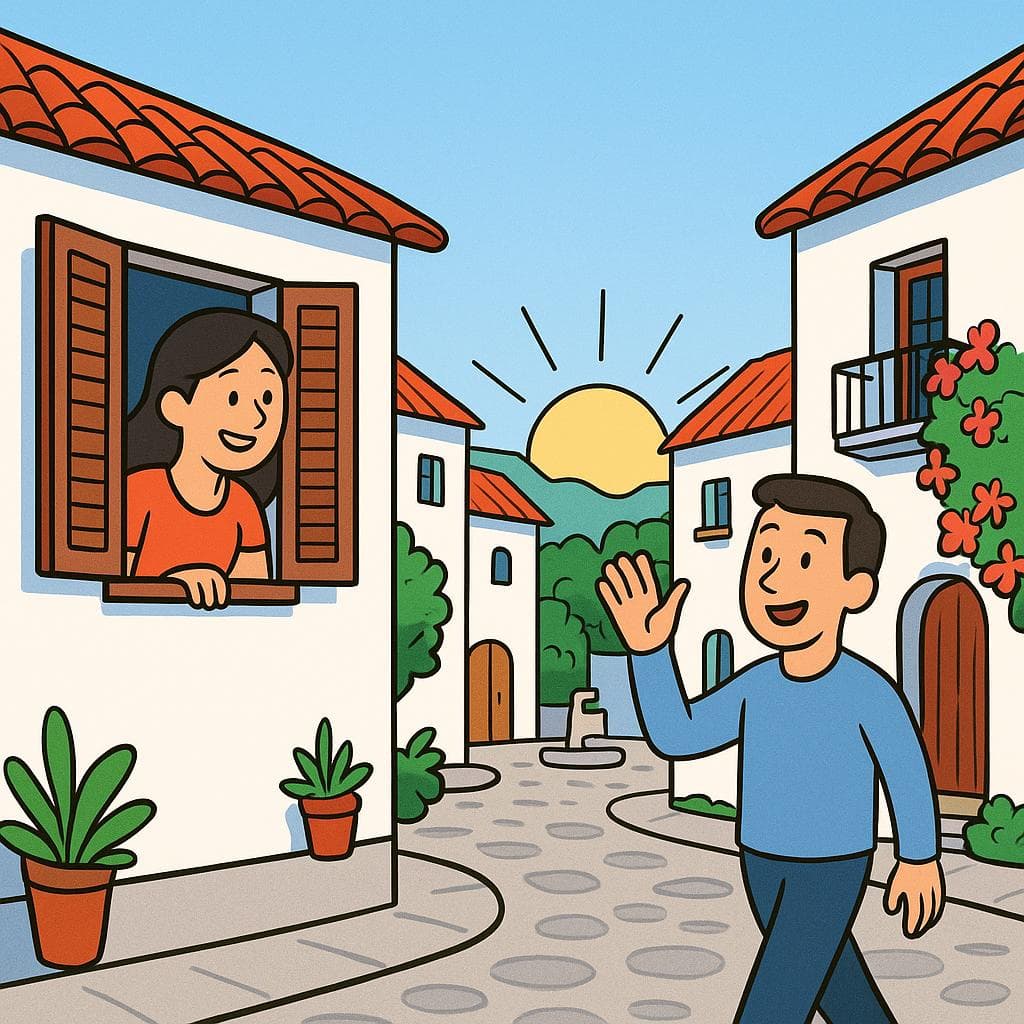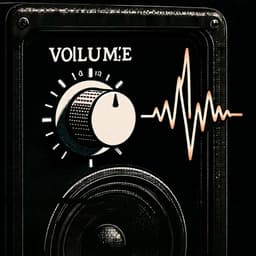Good morning
in SpanishBuenos días
/BWEH-nohs DEE-ahs/
This is the universal, standard way to say "good morning" in Spanish. It's always plural, literally meaning "good days," and is appropriate in any situation, from greeting a stranger to your family.

Greeting people with "Buenos días" is a warm and essential part of starting the day in Spanish-speaking cultures.
💬Other Ways to Say It
Buen día
/BWEHN DEE-ah/
A slightly more concise, singular version of "Buenos días." While universally understood, it's much more common in some Latin American countries than in Spain.
Buenas
/BWEH-nahs/
This is a super common, casual shortcut for "Buenos días," "Buenas tardes," or "Buenas noches." The time of day is simply understood from the context.
Muy buenos días
/MWEE BWEH-nohs DEE-ahs/
Adding "Muy" (very) makes the greeting more emphatic, polite, or cheerful. It's the equivalent of saying "A very good morning to you!"
¡Feliz día!
/feh-LEES DEE-ah/
This means "Happy day!" and is a warm, cheerful greeting. It's less of a standard 'good morning' and more of a well-wish for the person's entire day.
¡Arriba!
/ah-RREE-bah/
This literally means "Up!" and is a playful, energetic way to wake someone up, similar to "Rise and shine!" in English. It's not a standard greeting for people you meet outside the home.
🔑Key Words
Key Words to learn:
📊Quick Comparison
Here's a quick comparison to help you choose the best morning greeting for your situation.
| Phrase | Formality | Best For | Avoid When |
|---|---|---|---|
| Buenos días | Neutral | Any situation, formal or informal. It's the universal standard. | Never. This is always a safe and correct choice in the morning. |
| Buen día | Neutral | Casual and semi-formal situations, especially in Latin America. | In Spain, where it's much less common and 'Buenos días' is preferred. |
| Buenas | Casual | Friends, family, and informal settings like a neighborhood store. | Formal business meetings, interviews, or when addressing elders with respect. |
| Muy buenos días | Formal | Showing extra politeness, enthusiasm, or in formal professional contexts. | It might sound a bit too formal or intense for a quick, casual greeting between close friends. |
📈Difficulty Level
Generally easy for English speakers. The 'd' in 'días' is a bit softer than in English, pronounced with the tongue touching the back of the teeth.
This is a fixed phrase, so you just need to memorize it as is. There's no conjugation or grammar to worry about.
The main nuance is knowing when to switch to 'Buenas tardes' and understanding the cultural importance of greeting everyone in a room.
Key Challenges:
- Remembering it's always plural ('buenos días')
- Knowing the cultural cutoff time for 'morning' vs. 'afternoon'
💡Examples in Action
Buenos días, Señor Pérez. ¿Cómo está usted?
Good morning, Mr. Perez. How are you?
¡Buenas! ¿Qué tal, amigo? ¿Vamos por un café?
Morning! What's up, friend? Shall we go for a coffee?
Buen día, mi amor. ¿Dormiste bien?
Good morning, my love. Did you sleep well?
¡Muy buenos días a todos y bienvenidos a la conferencia!
A very good morning to everyone and welcome to the conference!
🌍Cultural Context
The Plural Mystery: Why 'Buenos Días'?
Ever wonder why it's plural? One popular theory is that it's a shortened version of an old greeting: "Buenos días nos dé Dios," which means "May God give us good days." Over time, it was simplified to just "Buenos días," keeping the plural form.
When Does Morning End?
The switch from "Buenos días" to "Buenas tardes" (Good afternoon) isn't at a strict 12:00 PM. It's cultural and often tied to lunchtime. In Spain, where lunch can be at 2 or 3 PM, you might hear "Buenos días" until then. In Latin America, the switch usually happens earlier, around 12 or 1 PM.
Greeting is Not Optional
In many Spanish-speaking cultures, it's considered polite and essential to greet everyone when you enter a small, enclosed space. This includes a doctor's waiting room, an elevator, or a small neighborhood shop. A simple "Buenos días" to the room at large is a sign of good manners.
More Than Just Words
A morning greeting is often accompanied by a physical gesture. This could be a handshake in a formal setting, a light hug, or one or two kisses on the cheek (besos) between friends, family, and even new acquaintances, depending on the country and context.
❌ Common Pitfalls
Using the Singular 'Bueno Día'
Mistake: "Saying "Bueno día" instead of "Buenos días.""
Correction: Always say "Buenos días."
Using 'Buenas' in Formal Situations
Mistake: "Greeting a potential employer with "¡Buenas!""
Correction: Use "Buenos días."
Forgetting to Greet Anyone
Mistake: "Walking into a small shop and immediately starting to browse without saying anything."
Correction: Say "Buenos días" to the shopkeeper upon entering.
💡Pro Tips
Combine with 'Hola' for a Friendly Touch
To sound even more natural and friendly, combine your greeting. Saying "Hola, buenos días" is very common and warm. It's like saying "Hi, good morning!" all in one.
When in Doubt, Use 'Buenos Días'
"Buenos días" is your safest bet. It's never wrong. Whether you're talking to a child, a friend, your boss, or the president, it's always appropriate in the morning.
Listen for the Switch to 'Tardes'
Pay attention to what native speakers around you are saying. If you walk into a cafe at 1 PM and hear everyone saying "Buenas tardes," that's your cue to switch from "Buenos días."
Expect a Question Back
A greeting is often the start of a small exchange. After you say "Buenos días," be prepared for the other person to respond and ask how you are with "¿Cómo estás?" or "¿Qué tal?"
🗺️Regional Variations
Spain
The switch to 'Buenas tardes' happens late, often after the traditional lunch hour around 2 or 3 PM. 'Buen día' is rarely used as a greeting here.
Mexico
'Buen día' is just as common, if not more so in some areas, than 'Buenos días.' It carries a very friendly, pleasant tone. The switch to 'tardes' is typically around 1 PM.
Argentina
'Buen día' is overwhelmingly the preferred casual greeting in the morning. Using 'Buenos días' can sound slightly more formal or foreign in some relaxed contexts.
Caribbean (e.g., Puerto Rico, Cuba, Dominican Republic)
The rhythm of speech is often faster. While 'Buenos días' is standard, the pronunciation can make it sound different to a learner's ear. Politeness and greetings are very important.
💬What Comes Next?
After you greet someone
Buenos días. ¿Cómo estás?
Good morning. How are you?
Muy bien, gracias. ¿Y tú/usted?
Very well, thank you. And you?
Greeting a barista at a coffee shop
¡Buen día! ¿Qué le doy?
Good day! What can I get for you?
Un café con leche, por favor.
A coffee with milk, please.
Entering an office in the morning
¡Buenas!
Morning!
¡Buenas! ¿Todo bien?
Morning! Everything good?
🧠Memory Tricks
This connects the Spanish word 'Buenos' to the similar-sounding English word 'Bonus,' creating a positive association that helps you remember the phrase means 'Good days.'
🔄How It Differs from English
The biggest difference is that the Spanish phrase 'Buenos días' is plural, literally 'good days,' while English uses the singular 'Good morning.' Additionally, the cultural expectation to greet everyone when entering a small room or shop is much stronger in Spanish-speaking countries than in many English-speaking ones.
🎯Your Learning Path
➡️ Learn Next:
Good afternoon
This is the next logical greeting to learn for continuing conversations throughout the day.
Good evening / Good night
Completes the set of daily time-based greetings.
How are you?
This is the most common follow-up question after a greeting.
Goodbye
Learning how to politely end a conversation is as important as starting one.
✏️Test Your Knowledge
💡 Quick Quiz: Good morning
Question 1 of 3
You walk into a small bakery in Madrid at 10 AM. What is the most appropriate way to greet the baker?
Frequently Asked Questions
Why is it 'buenos días' and not 'bueno día'?
It's a fantastic question! The greeting is a fixed, historical expression that's always plural. Think of it as wishing someone 'many good days' condensed into one phrase. Even though 'día' is singular, the expression itself is always 'Buenos días'.
What's the real difference between 'Buenos días' and 'Buen día'?
Functionally, they mean the same thing. The main difference is regional. 'Buenos días' is the universal standard, used everywhere. 'Buen día' is also widely understood but is much more common and popular in many Latin American countries like Argentina and Mexico than it is in Spain.
When should I stop saying 'Buenos días' and switch to 'Buenas tardes'?
There's no hard rule, but a good guideline is after the midday meal. In Latin America, that's often around 1 PM. In Spain, where lunch is later, you might say 'Buenos días' until 2 PM or even 3 PM. When in doubt, listen to what the locals are saying.
Can I just say 'Hola' instead of 'Buenos días'?
Yes, 'Hola' (Hi) works any time of day. However, adding the time-specific greeting makes it warmer and more polite. Saying 'Hola, buenos días' is very natural and friendly. In more formal settings, it's better to use 'Buenos días' on its own.
Is it okay to use 'Buenas' with my boss?
It depends on your relationship and the office culture. If it's a very relaxed, informal workplace and you have a friendly relationship, it might be fine. However, to be safe, it's always better to stick with the more formal 'Buenos días' in a professional setting.
Do I say 'Buenos días' to a group of people?
Absolutely! The phrase works for one person or a hundred people. When you walk into a room, you can say 'Buenos días' to everyone at once. It's the polite and expected thing to do in many social situations.
📚Continue Learning Spanish Phrases
Explore More Phrases in These Categories
Find similar phrases to expand your Spanish vocabulary:
Want to Learn More Spanish Phrases?
Browse our complete collection of Spanish phrases organized by situation, from basic greetings to advanced conversations. Perfect for travelers, students, and anyone learning Spanish.
View All Spanish Phrases →



